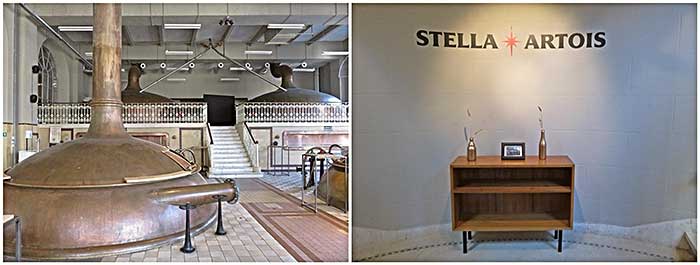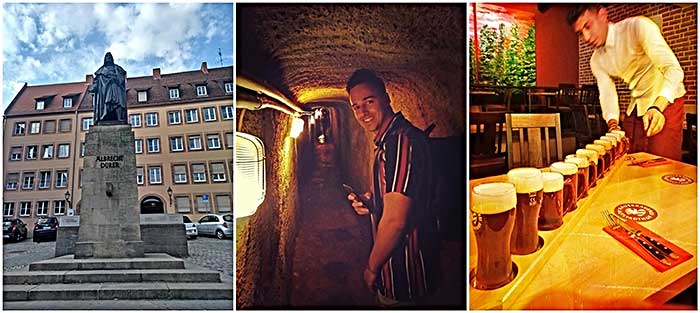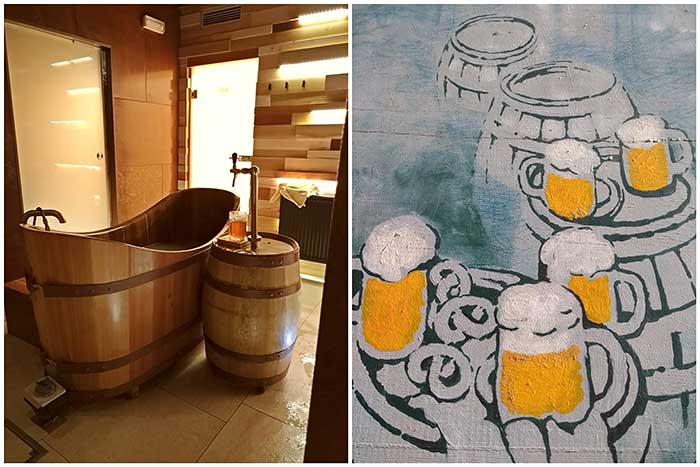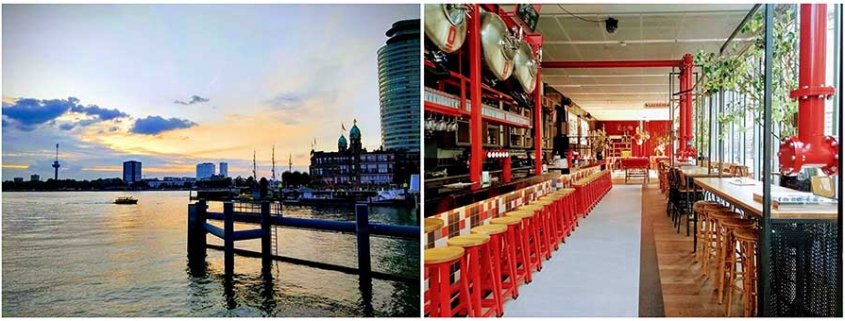Discovering European beer culture by train rather plane!
Guest Blog by Ramy Salameh
Munich’s “Oktoberfest” is not the only way to appreciate Europe’s thriving artisanal beer scene. Using the ageless ‘Interrail Pass’ was my passport to discovering a scenic, sustainable (taking note of the -‘Tagskryt’ – flight shame trend) and relaxed way to explore Europe’s lesser-known beer heritage, past, present and future.
Rotterdam – trend-setting innovation and sustainability
From Boarding Eurostar 9116 at London St. Pancras International just before 9am, I was sipping a ‘Noordt Dubbel’ dark craft beer at a Rotterdam bar called ‘Proeflokaal Reijngoud’ by midday. Home to an emerging craft beer scene, fits well with the city’s description as a ‘living lab’, a focal point of urban innovation, sustainability and experimentation.

This is no better showcased than by ‘Vet & Lazy’, a craft beer brewer, located in the bowels of ‘Tropicana’ a former subtropical swimming complex. The brewery promotes sustainability initiatives, even creating a residual beer made with coffee beans from the organic ‘Aloha Bar’ also located in Tropicana. From here, a quick skim across the River Mass by water-taxi brought us in front of a young brew master, Jazze Post. Operating out from ‘Thoms Stadsbrouwerij’ (brewery) located behind city hall; “we have a Thoms Pilsner, Pale Ale and IPA and they come direct from the tanks you see above the bar, so it’s unpasteurized and unfiltered which gives a unique taste. Our self-serve tables are also popular, especially during Oktoberfest events” he said, pointing the length of Rotterdam’s longest bar.
The whistle-stop visit to Rotterdam included dinner at the popular ‘De Matroos’, before departing the architectural landmark of ‘Centraal Station’. Passing windfarms and suburban life next to the tracks, we soon crossed the Belgium border to reach Leuven.

Leuven – Belgium’s capital of beer
Leuven is known as the ‘capital of beer’. A place where the brewing culture and university is absorbed into the fabric of the city. Katholieke Universiteit Leuven’s tentacles spread into almost every aspect of life, even researching the science of beer and using the UNESCO heritage, the 13th century ‘Great Beguinage’, once a closed community of pious women, as part of the campus. Students and beer has always been a winning formula. Leuven backs up this equation, with Belgium’s oldest university dating to 1425 and the world’s largest brewing company ‘AB inBev’, producers of Stella Artois. The youthful vibrancy of Leuven, is framed by historical edifices; following the main artery from the rail station, brought us to the Grote Markt (town square), ‘Oude Markt’ and palatial university library on Ladeuzeplein. Formations of bicycles criss-crossed the Grote Markt in front of two architectural sculptures, the late gothic 15th century St. Peter’s church, and the statue covered façade of the spectacular ‘Stadhuis’ (town hall).
Brimming with bars and known as the ‘longest bar in Europe’, the Oude Markt is crowned by a series of Flemish-style gables, amalgamating KU Leuven’s earliest university building , through which every student has and must pass; the Flemish-Renaissance style library, another unmissable student haunt.
Immediately outside the older part of Leuven is ‘Vaartkom & Sluisstraat’, a former industrial district being transformed through regeneration, with ‘Brouwerij De Hoorn’ – the old brewery building at its heart, where in 1926 the first Stella Artois was brewed; the brewery’s lineage stretches back to 1366 before Sebastian Artois took over as master brewer in 1708.
Close to Vaartkom is where the modern brewery pumps-out Stella Artois to over 80 countries and tours are offered, as they are at several craft beer micro-breweries in the rural outskirts of the city. Our visit to ‘Hof Ten Dormaal’, a family-run farmhouse brewery cultivating their own grains and hops, before turning it into an exciting range of craft beers was a journey that Jef Janssens, the family master brewer took us on; “we are not scared to experiment” he said as he placed a ‘Hemp’ beer called ‘Summer of 67’ next to a limited edition 12% Belgium Blond Ale aged in Jura Barrels, on the table with a heavily tattooed arm.

Janssens’s stereotypical hipster craft-brewer appearance was in contrast to Marc Andries, owner of microbrewery De Vlier; a chemical engineering graduate with a markedly different look, shared the same sense of experimentalism with a range of well curated beers.
Nuremberg – Tunnels and Red Beer
Changing trains at Liège-Guillemins station, enroute from Leuven to Nuremberg, unveiled an unexpected architectural gem, something that only rail travel can. Santiago Calatrava’s vaulted steel and glass structure arched over the platforms like a giant eyelid and peered out towards the city-centre panorama; certainly a fitting backdrop, as our bullet-nosed Deutch-Bahn ICE train glided through. “Beer saved us”! These were the sentiments of Nurembergers who survived allied bombings during WWII, having sought refuge within the 13th century subterranean rock-cut beer cellars, which had taken 400-years to complete. This wasn’t the only time ‘Beer’ was seen as a saviour, having replaced the undrinkable waters of medieval times. The red-sandstone walls still scarred by tunnellers and glow-in-the-dark phosphorescent plaques illuminating exits in WWII linked periods of history, just as the beer brewing purity laws of 1303, decreed by Nuremberg council, still characterise the city today.

Our descent below the surface, began directly behind the Albrecht Dürer statue, which alongside the nearby 16th century artist’s house, incredibly survived the WWII intact. The kilometres of tunnel network even stretches beneath the ‘Imperial castle’, once one of the most important royal palaces of the Holy Roman Empire, which still peers down on Nuremberg’s photogenic centre. The tour ended as we blinked back into daylight, emerging from below into the courtyard of ‘Hausbrauerei Altstadthof’, (brewery) to sample their malty Rotbier (red beer) and single malt whiskey (made from distilling beer).
Crossing the border and pine covered forests between Germany and Czech Republic, brought us to our final city destination, Pilsen.
Pilsen – Beer above and below the ground
Standing atop St. Bartholomew’s Church bell tower within Namesti Republiky (Republic Square), brought history, heritage and industry into focus across the patchwork of rooftops; from the sinewy chimney stacks representing Pilsen’s ongoing industry in the form of ‘Skoda’ and the world-renowned Pilsner lager factory ‘Pilsner Urquell’. Other notable buildings included the elaborate Moorish-Romanesque style ‘Great Synagogue’ and frescoed renaissance façade of the old town hall. As with Nuremberg, Pilsen’s history has a subterranean dimension, with kilometres of 14th century beer tunnels and vaults, accessed via the Pilsner Historical Underground Museum. Locking the wrought iron gate behind him, we again found ourselves snaking behind our guide as he explained early medieval finds and water wells, once numbering over 300.

These tunnels would have connected at some time with the beer cellars of our next stop ‘Pilsner Urquell Brewery’ several kilometres away, which was founded in 1839 under the stewardship of Bavarian master brewer Josef Groll, who created the first Pilsner-lager in 1842. All of which was explained during the brewery tour which was expertly narrated as we descended the brewery cellar complex, where we could tap our own Pilsner straight into our glass from huge oak barrels.
In a country that consumes the most beer per capita in the world, the chance to bathe in it at the ‘Purkmistr microbrewery’ on the outskirts of Pilsen, was no surprise. It seemed a fitting way to end our beer-hopping rail tour, being submerged in several litres of unfiltered and unpasteurized beer, mixed with water containing crushed hops and beer yeast, which is meant to support blood circulation and skin nutrition. The only tap associated with the bath, was the one to fill your glass with beer, helping me to think up my next theme and journey by Interrail; with rail access across 31 European countries the only limit was my imagination!
Fact Box: For more information go to:
Interrail – http://interrail.eu/
Rotterdamandpartners – https://en.rotterdampartners.nl/
Visit Leuven – https://www.visitleuven.be/en
Visit Nuremberg – https://tourismus.nuernberg.de/
Visit Pilsen – https://www.pilsen.eu/en/tourist/
.

Award-Winning Travel Journalist
.
Perhaps you are also intereted in:
Venice Simplon Orient Express from Paris to London
Finding your ‘mojo’ at Kurhotel Skodsborg
The Private Suite – LA’s ultimate airport luxury touchdown
.

 ©Ramy-Salameh
©Ramy-Salameh ©Bianca Demsa
©Bianca Demsa



 ©Tirol-Werbung, RobertPupeter
©Tirol-Werbung, RobertPupeter